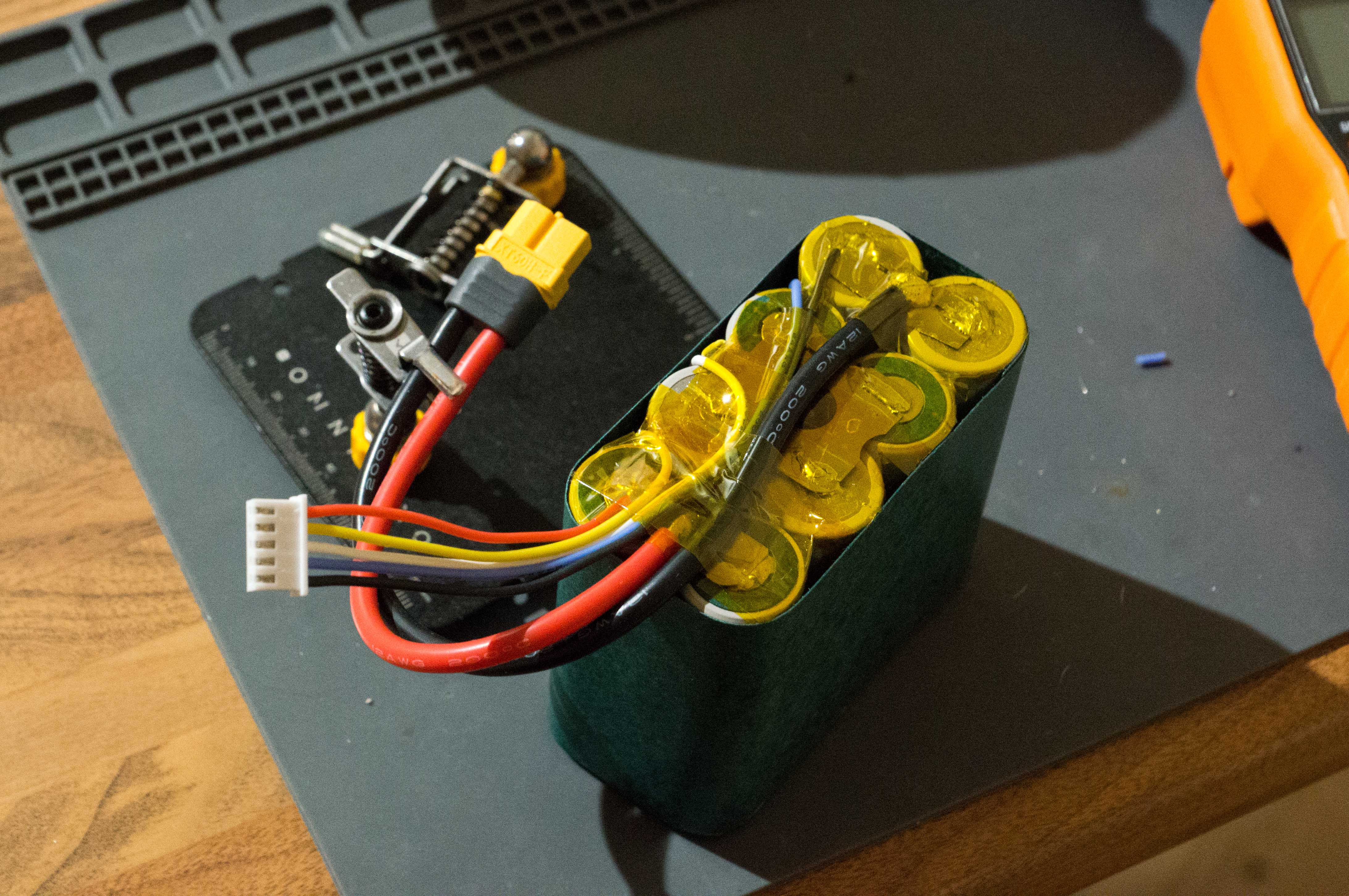Lithium Ion Batteries
Building and testing a 4S2P Lithium Ion battery pack
Years ago I had made a little 2S Lithium Ion (Li-Ion) battery pack from two 18650 cells to power my ZOHD Dart. The stock setup of a 1000 mAh LiPo managed a 20 minute endurance, but using the 3500 mAh Li-Ion pack stretched the endurance to about 80 minutes - impressive for a sub-250g aircraft! The benefits of a more power dense battery chemistry and drawback of a lower peak current draw compared to LiPos are well known to anyone in the UAS space, and I wanted to see how far I could push the endurance of my Orca using a big Li-Ion pack.
A fellow flying club member offered a set of cells to use for a new pack, some Molicel P42A 21700s, which boast a 45 A continuous discharge capability and 4200 mAh capacity. With 8 cells, a 4S2P battery pack with a combined capacity of 8400 mAh and discharge rating of 90 A can be constructed.
Building the battery pack
The requisite components to build a pack are quite simple. Besides the obvious wire and connectors, some nickel strips, kapton tape, adhesive barley paper, and heatshrink are all that are required. Without a spot welder, I chose to solder the cells together. The first step was to print a jig to hold the cells together in shape, lightly sand the terminals, and tin the terminals with some solder. It’s important to use a high iron tip temperature as the battery provides a large thermal sink to the terminals, but the temperature of the cell can’t rise too much or you risk damaging or destroying the cell.
 Tinning the battery terminals with solder
Tinning the battery terminals with solder
Next is to attach the nickel strips. I bought some 0.15 mm thick plates designed for this application, and they feature gaps near the centre of the cell to aid with reflowing the solder under the strip. I attached some balance leads with standard colour coordination to each cell terminal point.
 Adding nickel strips and cell balance leads
Adding nickel strips and cell balance leads
I added a small amount of hot glue between adjacent cells to maintain the pack structure, then added the main power wires to the end terminals. I would have prefered 14 AWG for this pack, but used the slightly heavier 12 AWG that I had on hand.
After adding plenty of kapton tape to the exposed terminals as necessary, I covered the long side and underside of the cells with a layer of adhesive barley paper, which adds a small amount of non-conductive protection to the pack. I then cut the wires to length and attached the XT60 main power connector as well as crimping the JST balance plug.
 Barley paper added to the side and bottom of the pack
Barley paper added to the side and bottom of the pack
Finally, I heatshrunk the entire pack and compared the results to a normal 3300 mAh 4S LiPo.
The Li-Ion pack weighs 577 g in total. Considering each of the eight cells weigh about 65 g, the overhead for the rest of the material is 57 g, or almost exactly 10% of the total weight. With a nominal maximum capacity of 8400 mAh, the pack weight efficiency is about 0.069 g/mAh, which compares favourably to the 0.102 g/mAh of the LiPo above.
Flight Endurance
Before flying, I stress tested the pack by running on the ground at full throttle for a few minutes. This only draws a maximum current of about 40 A, but this is the only aircraft I plan to use the pack with so it’s a representatve test. The battery fits very snugly in the battery bay and balances the same as my normal setup of two 4S LiPos.
I flew a single endurance flight. It was a cold day (temperatures somewhere between 0 and +5 degreed C) and I climbed to 120 m AGL and flew a wide circular loiter with 250 m radius at 15 m/s for the duration. This flight profile gives an almost wings-level attitude for the flight, with an average roll angle below 2 degrees. At takeoff, the cell voltage was 4.17 V, and I landed once the cell voltage reached 3.2 V, which gave a total flight endurance of 95 minutes and flight distance of 82 km. The current monitor is a bit out of calibration, claiming a use of 8500 mAh from the 8400 mAh battery, but assuming we used the full 8400 mAh this puts the aircraft efficiency at 102 mAh/km.
 Logged results of battery voltage and current draw during the endurance flight
Logged results of battery voltage and current draw during the endurance flight
This is a fantastic result but there is room for improvement. Ensuring a full 4.2 V per cell on launch and better exploiting the high depth of discharge the Li-Ion cells provide could provide a noticeable benefit. Indeed, the P42A datasheet shows the cell voltage dropoff is not significant until about 3.0 V per cell at the cruise current draw of 5 A or less. Similarly, warmer air temperatures can extend the life of the cells by about 5% at best, but this may not be significant in this application due to the self-warming nature of the cells under load.
Moving to a more efficient airframe would significantly boost the maximum endurance. The 102 mAh/km figure compares unfavorably with the ~65 mAh/km previously achieved with my ZOHD Dart. This is the unsurprising result when comparing a single-engined plank wing to a twin conventional aircraft, so perhaps the next step is to build a 4S wing for future endurance flying.


